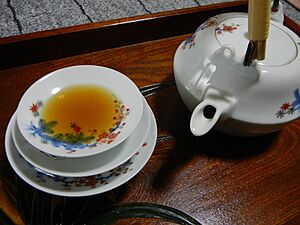Akumochizake facts for kids
Akumochizake (灰持酒) (also called (灰汁持ち酒)) is a special type of Japanese sake. What makes it unique is that Ash is mixed into the brewing liquid. This process gives it a distinct flavor and helps it last longer.
Contents
How Akumochizake is Made
Akumochizake has a long history, going back even before the Nara period in Japan. The first version was called Kurozake. It was used for special ceremonies.
To make it, people would add rice and water to rice malt. This mixture would then ferment. After that, ash from the root of a plant called trichotomum was added. Today's Akumochizake uses a similar process.
Regular sake is usually acidic. But the ash in Akumochizake is alkaline, which means it's the opposite of acidic. This alkaline ash stops harmful bacteria from growing. These bacteria can make sake go bad. The ash also helps create a reddish color and a special taste. This happens through a process called the Maillard reaction. After the ash is added, the liquid is filtered, so no ash is left behind.
The name "ash-mochi-zake" means "ash-holding sake." This name comes from the ash being added to stop bacteria and make the sake last longer. In contrast, regular sake has been called "himochi-zake" since the Edo period. This name means "fire-holding sake" because it was heated to keep it fresh.
Making Akumochizake continued in many parts of Japan, especially in the western areas. People kept improving how it was made. Today, Akumochizake is not just for drinking. It's also used as a cooking sake, much like Mirin, because of its unique sweetness and flavor. Different regions have their own names for their Akumochizake.
Akazake
Akazake (赤酒, lit. Red Sake) is a type of Akumochizake made in Kumamoto Prefecture. It's called "red sake" because it has a rich brown or reddish-brown color.
During the Edo period, the Kumamoto area, led by Katō Kiyomasa, made it illegal to produce or bring in other types of sake. They protected Akazake by buying ash from outside the region. After the Satsuma Rebellion (a war), more people moved to Kumamoto. This led to other sake being made and sold. However, the tradition of making red sake continued until before World War II.
Akazake is made using an old method. It has a strong, unique flavor, which some describe as having an ashy smell, sweetness, and thickness. It can be made with less white rice compared to other sake. However, as more efficient sake production grew, the demand for this traditional, heavy red sake went down. During World War II, there wasn't enough rice. So, making Akazake was stopped to save rice for other sake.
After the war, production started again because Kannushi (Shinto priests) and others asked for it. But out of 15 breweries that made it before the war, only two remained: Zuitaka and Chiyonen Shuzo. Zuitaka was damaged by the 2016 Kumamoto earthquakes. They temporarily stopped making it but managed to restart using their remaining unrefined sake.
How Akazake is Made
To make Akazake, Glutinous rice is added to the ingredients. The amount of water is cut by almost half. Barley malt is added at the end of the brewing process for more fermentation. Just before the liquid is filtered, a mix of lime and wood ashes called "shiratama ash (白玉灰, Shiratama hai)" is added. This helps make the liquid clear. Then, it is stored without being heated.
Main Uses of Akazake
In the past, Akazake was always drunk at weddings and funerals. Today, people in Kumamoto prefer other drinks. So, it's not as common for daily use. However, it is still often used for toso (a special New Year's drink). Akazake made for cooking is also sold. Professional chefs and food makers use it. Its sweetness and slight alkaline nature make food rich and soft when cooked.
Jishu
Jizake is an Akumochizake mostly made in Kagoshima Prefecture. In Kagoshima, people sometimes call shochu "men's sake" and Jizake "women's sake."
Jizake is the only sake still brewed in Kagoshima. This means it is very similar to regular sake among all Akumochizake types. The process is almost the same as for sake. But, shochu and wood ash are added just before the brewing liquid is filtered.
Main Uses of Jizake
In local dishes like sake-zushi, a lot of Jizake is used instead of vinegar. It is also sometimes used in Satsuma-age (a type of fish cake). So, it is mainly used as cooking sake.
Jiden-shu
Jidenshu is a type of sake made in the Izumo region of Shimane Prefecture. It has been made there since ancient times.
Like Akazake, Jidenshu production was stopped during wartime because of rice shortages. It was not made for a long time after the war. In 1989, a company called Yoneda Shuzo in Matsue worked with local volunteers to bring it back. By 1990, it was restored as a seasoning sake.
Jiden-shu Manufacturing Process
To make Jiden-shu, glutinous rice and long-aged koji (a special mold) are added. The amount of water is reduced by more than half. Wood ash is added a few days before the brewing liquid is filtered. This makes Jiden-shu the most concentrated type of Akumochizake.
Main Usage of Jiden-shu
It is used in local dishes and fish paste products for seasoning and to make teriyaki sauce.


